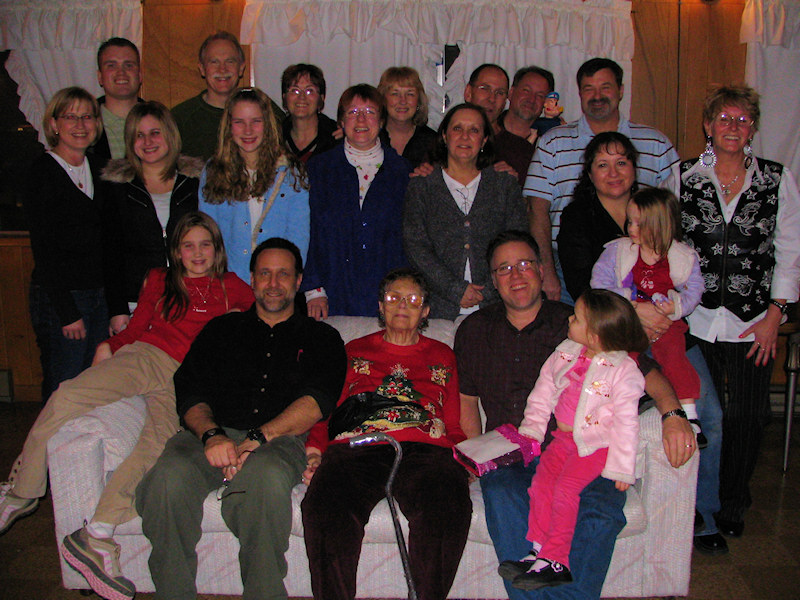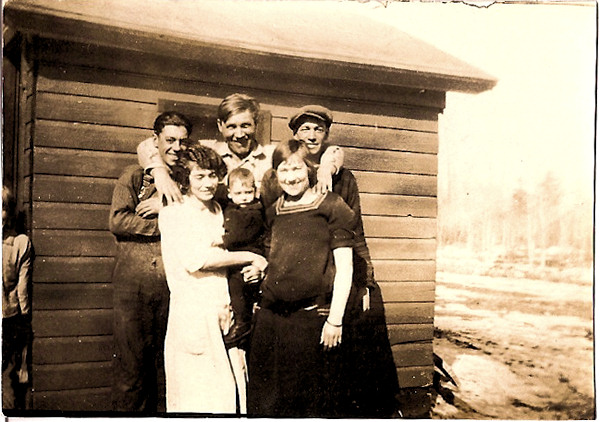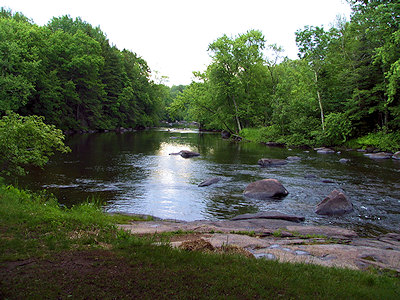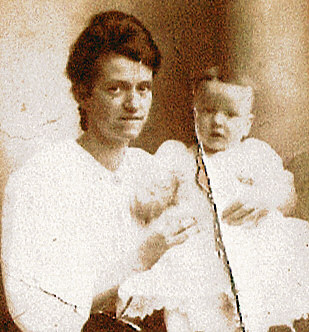It happens all the time in genealogy research. You are following a course of research, nose close to the ground, sniffing and tracking down this path and that, and wham! Your nose slams up against a dead end sign. There’s no where to go.
What do you do?
I believe that every ending is just a beginning. It’s just a matter of doing some backtracking, looking for other doors to open that you may have missed along the way.
What do you look for? That’s a harder question. The detail can be so small you will miss it on the first, second, and even fifth pass through the information and resources. Or it will slam you upside the head with its blatant obviousness.
Here are some of the clues I uncovered after hitting a few brick walls in my own family history research. They might give you some insights into the clues you may have missed along the way.
Records Give Clues
Just because you are “sure you know” exactly when, where, and how a relative was born, married, gave birth, and died, doesn’t mean you have the “rest of the story”.
A friend of mine was so confident one relative’s death, she skipped locating and reading a death certificate. Stuck down a one way street to nowhere researching information on him, she decided to spend the USD $20 for a copy of the death certificate, for no other reason than to fill in the missing paperwork.
The death certificate arrived and sat on her desk for months, since she felt the information it contained was “known”. When she finally got around to opening it, she discovered that the birth father was different on the death certificate than the birth certificate. So what happened?
Suddenly another door opened in her research. Why are the names different? Further investigation found that this relative had discovered his father was not his biological father. His mother had married quickly and hid the facts of her pregnancy from the world. He found his biological father and established a relationship, therefore changing his records during his lifetime, which showed up on his death certificate.
In the case of my own grandfather, digging through old records, my mother and I discovered that the name of the mother on his birth certificate was different from his mother’s name on his death certificate. After much digging, we found that the person was the same. It seems that great grandmother had been adopted after her mother’s death when she was a small child. She’d taken on her adopted family’s name and dropped the “a” from Helena to be just “Helen”. If we hadn’t been looking for details, we’d have taken it for granted that the name would have been the same and lost part of the fascinating story of our family’s history. More careful research revealed that the adopting family was also a relative by marriage, and that they took in more of our family members later on in life after Helen died. We’re eager to learn more about these honorable and compassionate people.
Records on vital statistics and the recorded details of a person’s life can and does often change throughout their life time. Nicknames become legally acceptable names. Birth dates, marriage dates, all dates “thought” to be right can be found to be listed differently on different records. Deeds, property records, and even probate records and wills can suddenly turn up new or different information and details.
Sometimes those records can also be a dead end. Searching for the orphanage my grandfather was in for many years, we found a note that he had been placed there by the Juvenal court system. Tracking down information there, we found the Juvenal court records dating back past the 1960s had been destroyed completely. According to the court clerks, there was no possibility of finding any copies of these records or information. Obliterated. Dead end.
Well, dead end until, after pleading for more information, someone mentioned that papers might have been filed with other courts for adoption, contest, or other legal reasons, and those agencies held onto their records for longer periods of time. I’m tracking down those avenues as I write this article. So who knows where a once dead end may lead by tracking other potential records.
Dates Can Lie and Why
After years dealing with the issue of no birth certificate or exact date or location of one of my grandfather’s birth, we thought we had come to an end. We knew he had lied about his age on his military records, entering the service between 14 to 16 years old after getting out of the orphanage, but which one was close to right? Even with a possible location, how many years forwards and backwards should we research?
Deciding to track down an unexplored and believed impossible track to follow, I decided to journey to Portland, Oregon, to find the records in person. In anticipation of that search, I contacted the Catholic Charities organization for the area to help me possibly locate his records from his stay in a Catholic children’s home at the beginning of the century. From among the few words on one line in an ancient record book from the first decade of the 1900s was found dates for arrival and departure from the Catholic Children’s Home he was in.
The woman helping me said she was sorry there wasn’t more specific and helpful information, but I drowned her out with my shouts of joy and discovery.
With this little bit of chronological information, we were able to pull from all the rest of the records we had to narrow down his birth year from a ten year span to two to four years. Amazing!
People lie about their ages for many different reasons. And many of those lies end up in official papers. Some lie about their age to appear younger for social or marital reasons. Others want to appear older so they can drink, drive, vote, or join the military, or for more social and personal reasons. Once a lie is started, it can be hard to change or correct. Record after record continues the lie, whether the individual intended the lie to continue or not.
Sometimes the difference in dates isn’t due to a lie of the individual but the parent, trying to get their child into a school or group with certain age limits or restrictions, or even to hide the fact that the child was born a little “early” in the marriage. The child may not know their age has been changed until later years.
Sometimes schools and other agencies will accidentally make a mistake in a vital statistic and the mistake will be carried on for years before caught. Other times, the issue of what time of year a child is born in complicates school records, being born outside their age ranges. So while most children might be six to seven years old in the first grade, the child’s birth date might make her actually five to eight years old in the first grade, though the tendency would be for older rather than younger at that age.
Census records are excellent for helping genealogists track down relatives’ ages and locations, but even these have problems. A nine may look like a four, or a one look like a seven. I’ve seen eights and sixes resemble each other, too. An entry goes into the family history records as 1784 when it should be 1769. Another researcher may find that data and assume they got the numbers right. Thus the error is carried forward.
Life spent trying to collaborate dates for a family history researcher is tough. Such researched based upon assumed ages can get complicated, so broaden your age range to widen your research if you get stuck. Look for more than one source to validate the dates and ages, if possible, to make sure you get it right, or at least as close to right as possible.
My Name is…
When I began my third grade in a new school, my mother received a phone call a week or so after school started asking when I was going to be attending class. Since I was in school every day, my mother was confused. Was her young child skipping class somehow?
It turned out that the teacher calling roll used my “real” name from the school records instead of my nickname, which I’d grown up with, fairly oblivious to the fact that I had another name. “Lori” was my nickname, and “Lorelle” my legal name. No one called me Lorelle, so I didn’t respond when I heard it amid the noisy confusion of morning roll call. I was there, so they had to know it. What did I care? Now, many decades later, no one calls me “Lori” and I would never respond to it, having adjusted to “Lorelle”. A bit of a switch.
People have nicknames and change their names throughout their lives, through marriages, adoption, finding birth parents, divorce, legal reasons, or just because. Tracking name changes and variations is confusing.
Our family photo album listed “Louella Pinder” as my great grandmother. Believing this was her maiden name, twenty-five years of unsuccessful genealogical research later, I discovered that Pinder isn’t her maiden name. It might not even be her first, second, or third married name. We don’t know yet. A copy of her death certificate gave us a different name for her father, Brunner from England. We can’t find any marriage records for her as Pinder yet. All we have is a listing of her last known husband, Lewis S. Parrett, on her death certificate. We only have family stories that tell us she was married to more than one person, and possibly never to my great grandfather. After twenty-five years of dead-ends, we now have a new starting point.
Chasing down multiple marriages in your family tree is a challenge, especially when it comes to children. Which child belongs to which parent and who took on whose name in the process? Did the children come from another father with a different name or did they change their last names to match their new step-father?
And then someone decides that the surname isn’t spelled right or wrong and changes it.
My husband’s family was originally von Vossen, but at some point they became Van Fossen, though other variations by family members resulted in Von Fossen and Van Vossen. Today, while some members of the living family use Van Fossen, some eliminated the space in the last name, using VanFossen in order to deal with name problems that come with the computer age. Though, when we showed up for a camping reservation in Yosemite National Park and after 45 minutes of looking in the computer for a reservation under Brent VanFossen, we found it under Fossen Van Brent. Go figure.
Look through records for changes and variations in names. Some children are given the new version of the family name at birth, others change their names during their lifetimes. Often the spellings are similar and sound the same, like von Vossen and VanFossen, but other times they are very different, like Desborough becoming Disbrow.
Some name variations are made by those filling in the forms. I found records for my great-grandmother listed as “Louella”, “Lulu”, and “Lula”. One member in our family had their name misspelled on the birth certificate, which legally set her name in a fashion different from what the parents’ wanted. Instead of filing the papers to legally change the spelling, or just going on with life spelling the name by the preferred method, explaining to future legal name requests that it was misspelled on the birth certificate, they choose to go with the change as it took the name from ordinary to slightly different with the spelling change.
There are many common nicknames for popular names found in every language. In English, Eugene is Gene, Elizabeth is Betty, Kathryn may be Catherine, and James is Jim. In olden times, Mary became Polly, and anyone could be nicknamed “Bud” or “Buddy” no matter what their real name was. Junior, while actually a suffix, can be used as a child’s name long enough, it actually becomes their “name”. I heard of one family with a James I, James II, and James III, still living in the same household, becoming First, Second, and Third as their nicknames, though how long that was continued after the death of the other James is hard to know.
In Russia, it often feels like everyone is named Alexander. When a Russian Alexander migrates to another country and language, this is often shortened to Alex. In their native country and among family members, Sasha is a nickname for Alexander.
Ancestors come from Scandinavia? From Finland, Denmark, Sweden, or Norway? Then expect that their names underwent some drastic changes. In researching our Anderson family arriving from Norway in 1851, we found that “Anderson” was a catch-all name for Norwegians. There are a lot of Andersons whose original names were nothing like Anderson. And there are spelling variations on Anderson such as Andersson, Andersen, and Anderssen. This makes tracking them past immigration, without naturalization, immigration, or birth certificate records, nearly impossible without their original family name.
Living in Spain for a while, I grew accustomed to people with 14 names, most of them based upon their mother and grandmother’s names. Juan Marie Jose Antonio Franco del Mar Arolla is a mouthful, but imagine what that might have become had they immigrated to the United States in the 1800s when changing a name to something “American” was normal? John Smith?
Then there is the middle name issue. Many people who don’t like their first name, use their middle names as their “first” name. This migrates into official documents, too. We had a Rudolph Erwin Anderson, who was called “Rudy” at work and in newspaper articles, but we discovered many early records and census reports referring to Erwin Anderson, no Rudolph to be found but the ages, dates, and places all matched. To add to the confusion, my mother uncovered old letters written to her by him signed “Uncle Erve”. I spent a bit of time researching for an “Ervine” in our family tree until we found another note that explained that “Uncle Erve” was really “Uncle Erwin”, and he used the Norwegian sounding “v” for the “w” in pronouncing “Er-vin”, thus “Erve”. Who knows what happened to the Rudolph. We’ve not found an explanation for that yet.
Each language and culture has their own common nicknames that make their way into the family tree so learn about those variations to help you narrow down which name is which to help you with your records.
Sometimes It’s the Smallest Detail You Missed
Going through some family papers, I recently found a source reference to “per Ma”. I suddenly realized that I wasn’t sure who wrote these papers and who “Ma” was. Because they had arrived within a collection from a specific person, I assumed that they were the source of all the information. But she never called her mother “Ma”. She was always “mom” or “mother”. A closer look revealed the writing was very close but not an exact match to the original author’s handwriting. Clearly related or attending the same school and teachers, but just a bit different that couldn’t be accounted for by age or health.
Luckily, the original compiler of the papers is still alive so I was able to contact her and confirm that this particular paper was actually written by her uncle, so “Ma” was not her mother but his. Thus a new avenue of research was opened. I was trying to match the family history notes in these papers with her mother not his!
I spent a lot of time recently converting piles of childhood stories written by my older relatives about their life “on the farm” in Wisconsin. Having grown up with these stories, I thought I knew them backwards and forwards. While transcribing them into text to publish and share with the family, I found amazing details that fleshed out missing information from many relatives I knew, and didn’t know, about. I suddenly learned names of ancient aunts and uncles and cousins not in my research from the casual mention of things like “lived near Uncle Ralph, Ethel’s son” and “Little Alice came to play with us. I didn’t like my cousin but we had to play with her.”
These were small details I’d always missed when reading these stories with my family or by myself. Now that I’m seriously researching this information four our family tree, and aware of the holes in my research, every detail matters. This radar for discovering details changes across time as well as experience. A few years ago I’d read through this same material, and assumed I’d sifted it thoroughly for every detail I could extract. Clearly I hadn’t. It makes me wonder what else I might be missing.
Go through your research material thoroughly at least once a year. Take advantage of the way your brain and awareness levels changes with time and experience. Maybe you didn’t need to know where the family lived in 1906 but now you do. Or you assumed the name on the death and birth certificates matched, just because they “should”, not because they do or don’t. Your need to know will change with your research, so return back to the records and dig with new intentions and expectations.
One last thought about finding the smallest detail in your search to avoid a dead end in your research. Keep an open mind. You never know what you will find when or where, so avoid going in with assumptions or expectations. When you limit yourself to only a specific task, narrowing your focus, you may miss the details that will answer questions later down your research path. Make lots of notes, keep track of what you find and where, and remind yourself to follow up on all the details, not just the one you are currently tracking down.
If you keep looking at dead ends, you might miss the open door next to it.
Most Recent Articles by Lorelle VanFossen
- The Myths and Mysteries and Hunt for Nicholas Knapp
- The Perpetual Calendar
- GenSmarts: Reminder to Not Assume
- Gensmarts Saves Your Family History Research Life
- Digging Through Historical Newspapers Online






4 Responses to Every Ending is Just a Beginning: It’s All in the Details